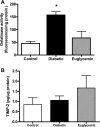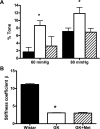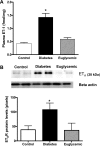Glycemic control prevents microvascular remodeling and increased tone in type 2 diabetes: link to endothelin-1
- PMID: 19176890
- PMCID: PMC2698601
- DOI: 10.1152/ajpregu.90537.2008
Glycemic control prevents microvascular remodeling and increased tone in type 2 diabetes: link to endothelin-1
Abstract
Medial thickening and vascular hypertrophy of resistance arteries can lead to cardiovascular complications associated with diabetes. While previous studies have established a role of type 1 diabetes in vascular remodeling, we recently extended these observations to type 2 diabetes and reported increased collagen deposition due to alterations in matrix metalloproteinase expression and activity in mesenteric resistance arteries. These studies also showed that remodeling response was mediated by endothelin-1 (ET-1) via activation of ET(A) receptors, whereas blockade of ET(B) receptors exacerbated the remodeling. However, the effectiveness of glycemic control strategies in preventing these vascular changes, including activation of the ET system still remained unclear. Also, very little is known about whether and to what extent reorganization of the extracellular matrix (ECM) affects vascular compliance and vasomotor tone. Accordingly, this study assessed structural remodeling of mesenteric microvessels, vascular compliance, and myogenic tone, as well as the role of matrix metalloproteinases (MMP) in mediating these processes. Spontaneously diabetic, non-obese Goto-Kakizaki (GK) rats, a model for type 2 diabetes, and normoglycemic Wistar rats were used for the studies. A subset of GK rats were administered metformin to achieve euglycemia. Glycemic control normalized the increased media-to-lumen ratios (M/L) and myogenic tone seen in diabetes, as well as normalizing plasma ET-1 levels and mesenteric ET(A) receptor expression. There was increased collagen synthesis in diabetes paralleled by decreased collagenase MMP-13 activity, while glycemic control attenuated the process. These findings and our previous study taken together suggest that hyperglycemia-mediated activation of ET-1 and ET(A) receptors alter vascular structure and mechanics in type 2 diabetes.
Figures






References
-
- American Diabetes Association. National diabetes fact sheet. American Diabetes Association [article online at http://www.diabetes.org/diabetes-statistics.jsp], 2008.
-
- Bitar MS, Al-Saleh E, Al-Mulla F. Oxidative stress-mediated alterations in glucose dynamics in a genetic animal model of type II diabetes. Life Sci 77: 2552–2573, 2005. - PubMed
-
- Centers for Disease Control, and Prevention. National Center for Health Statistics [article online at http://www.cdc.gov/nchs/fastats/lcod.htm], 2008.
-
- Cheng ZJ, Vaskonen T, Tikkanen I, Nurminen K, Ruskoaho H, Vapaatalo H, Muller D, Park JK, Luft FC, Mervaala EMA. Endothelial dysfunction and salt-sensitive hypertension in spontaneously diabetic Goto-Kakizaki rats. Hypertension 37: 433–439, 2001. - PubMed
-
- Collier A, Leach JP, McLellan A, Jardine A, Morton JJ, Small M. Plasma endothelin-like immunoreactivity levels in IDDM patients with microalbuminuria. Diabetes Care 15: 1038–1040, 1992. - PubMed
Publication types
MeSH terms
Substances
Grants and funding
LinkOut - more resources
Full Text Sources
Medical

